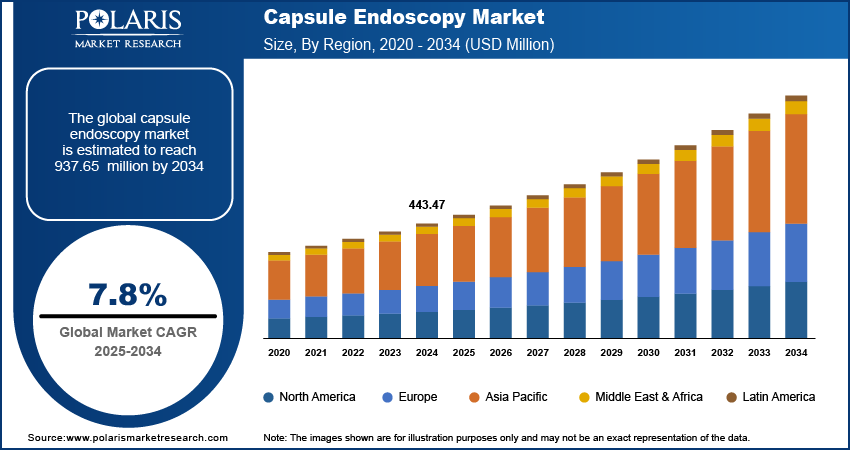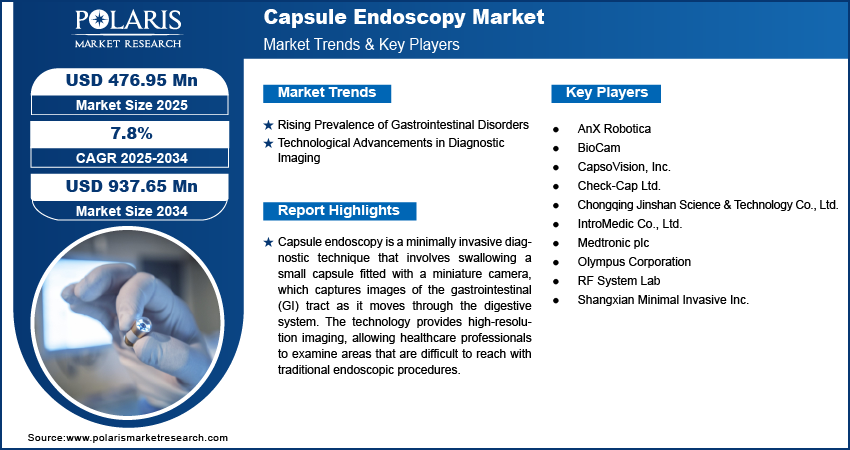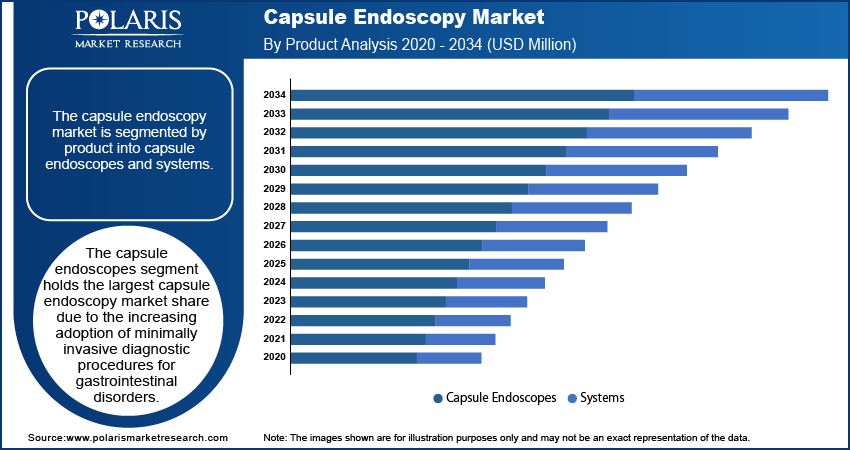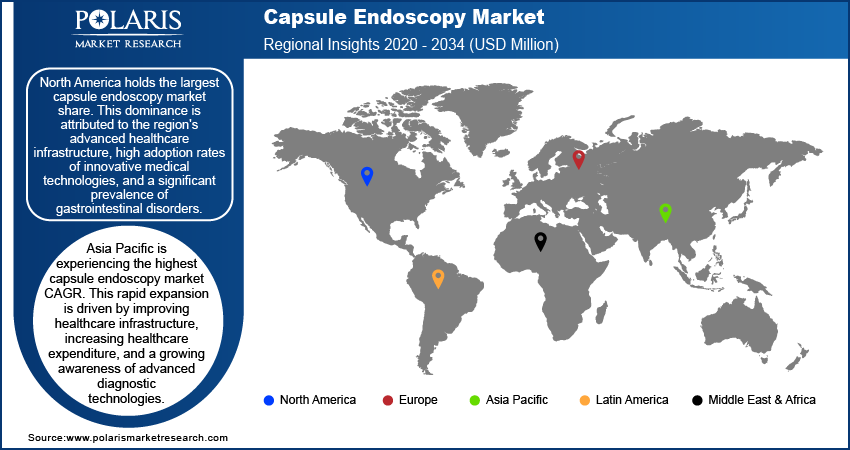
Capsule Endoscopy Market Size, Share, Trends, Industry Analysis Report: By Product (Capsule Endoscopes and Systems), Application, End Use, Type, and Region (North America, Europe, Asia Pacific, Latin America, and Middle East & Africa) – Market Forecast, 2025–2034
- Published Date:May-2025
- Pages: 116
- Format: PDF
- Report ID: PM2326
- Base Year: 2024
- Historical Data: 2020-2023
Capsule Endoscopy Market Overview
The capsule endoscopy market size was valued at USD 443.47 million in 2024. The market is projected to grow from USD 476.95 million in 2025 to USD 937.65 million by 2034, exhibiting a CAGR of 7.8% during 2025–2034.
The capsule endoscopy market focuses on minimally invasive procedures for examining the digestive tract. This technology utilizes a small, swallowable capsule equipped with a camera to capture high-resolution images of the gastrointestinal system, aiding in the detection of conditions such as ulcers, polyps, and internal bleeding. The market has witnessed substantial growth due to capsule endoscopy’s ability to provide a painless and efficient alternative to traditional endoscopic methods, improving patient comfort and diagnostic accuracy. The demand for capsule endoscopy is expanding across hospitals, diagnostic centers, and specialty clinics as healthcare providers seek advanced solutions for early disease detection, thereby driving the capsule endoscopy market growth.
The rising prevalence of gastrointestinal disorders, including Crohn’s disease and colorectal cancer, has fueled the need for innovative diagnostic tools. Additionally, increasing awareness about non-invasive screening methods and advancements in imaging technology have contributed to the capsule endoscopy market expansion. Supportive government initiatives, growing healthcare expenditures, and the rising adoption of telemedicine are further improving market penetration. The market is expected to witness steady growth in the coming years with continuous research and development efforts aimed at improving capsule design and functionality.

To Understand More About this Research: Request a Free Sample Report
Capsule Endoscopy Market Dynamics
Rising Prevalence of Gastrointestinal Disorders
The increasing incidence of gastrointestinal (GI) disorders, such as Crohn's disease, celiac disease, and obscure gastrointestinal bleeding, has significantly heightened the demand for advanced diagnostic tools like capsule endoscopy. According to a 2022 report by the National Institute of Diabetes and Digestive and Kidney Diseases (NIDDK), approximately 60 to 70 million people in the United States are affected by digestive diseases, underscoring the widespread nature of these conditions. Capsule endoscopy offers a non-invasive, patient-friendly alternative to traditional endoscopic procedures, enabling comprehensive visualization of the small intestine, which is challenging to assess with conventional methods. This capability is particularly crucial for diagnosing conditions such as obscure GI bleeding, where the source of bleeding is not identified through standard endoscopy or colonoscopy. The ability of capsule endoscopy to provide detailed images of the entire small bowel improves diagnostic accuracy, facilitating timely and appropriate therapeutic interventions. Consequently, the escalating prevalence of GI disorders directly contributes to the growth of the capsule endoscopy market.
Technological Advancements in Diagnostic Imaging
Continuous innovations in medical imaging technology have markedly improved the efficacy and applicability of capsule endoscopy. Modern capsules are now equipped with high-resolution cameras, extended battery life, and enhanced data transmission capabilities, allowing for more precise and comprehensive examination of the gastrointestinal tract. A 2023 study published in the Journal of Gastrointestinal and Liver Diseases highlighted the development of capsules with adjustable frame rates and improved illumination, which significantly enhance image quality and diagnostic yield. Additionally, advancements in software algorithms for image analysis have streamlined the interpretation process, reducing the time required for physicians to review the extensive data generated during the procedure. These technological improvements not only augment the diagnostic accuracy of capsule endoscopy but also expand its indications, making it a more versatile tool in the detection and monitoring of various GI pathologies. As these innovations continue to evolve, they play a pivotal role in propelling the capsule endoscopy market demand.

Capsule Endoscopy Market Segment Insights
Capsule Endoscopy Market Assessment by Product
The capsule endoscopy market segmentation, based on product, includes capsule endoscopes and systems. The capsule endoscopes segment holds the largest capsule endoscopy market share. This dominance is largely attributed to the increasing adoption of minimally invasive diagnostic procedures for gastrointestinal disorders. Capsule endoscopes offer a patient-friendly alternative to traditional endoscopy, allowing for comprehensive visualization of the gastrointestinal tract without discomfort. The rising prevalence of conditions such as obscure gastrointestinal bleeding and Crohn's disease has further propelled the demand for these devices. Technological advancements, including enhanced imaging capabilities and extended battery life, have improved the diagnostic accuracy and efficiency of capsule endoscopes, driving the segmental growth in the market.
Capsule Endoscopy Market Evaluation by Application
The capsule endoscopy market is segmented by application into OGIB (Obscure GI Tract Bleeding), Crohn’s disease, small intestine tumor, and others. The OGIB (Obscure GI Tract Bleeding) segment holds the largest market share. This dominance is primarily due to the increasing utilization of capsule endoscopy for diagnosing obscure gastrointestinal bleeding, offering real-time visualization and comprehensive assessment of the small intestine. The shift towards capsule-based endoscopic screening over traditional methods has further boosted this segment's dominance.

Capsule Endoscopy Market Regional Analysis
By region, the study provides the capsule endoscopy market insights into North America, Europe, Asia Pacific, Latin America, and the Middle East & Africa. North America holds the largest market share. This dominance is attributed to the region's advanced healthcare infrastructure, high adoption rates of innovative medical technologies, and a significant prevalence of gastrointestinal disorders. In the US, the well-established healthcare system and comprehensive insurance coverage facilitate the widespread use of capsule endoscopy for diagnosing conditions such as Crohn's disease and obscure gastrointestinal bleeding. Additionally, the presence of leading medical device manufacturers and ongoing research and development activities further boost the demand, thereby driving the capsule endoscopy market in North America.
Asia Pacific is experiencing the highest capsule endoscopy market CAGR. This rapid expansion is driven by improving healthcare infrastructure, increasing healthcare expenditure, and a growing awareness of advanced diagnostic technologies. Countries such as China and India, with their large populations and rising incidence of gastrointestinal diseases, present significant opportunities for market growth. Government initiatives aimed at enhancing healthcare access and quality, coupled with the increasing adoption of minimally invasive procedures, further contribute to the accelerating market demand in this region.

Capsule Endoscopy Market – Key Players and Competitive Insights
The capsule endoscopy market features several prominent companies actively offering relevant products. Key players include Medtronic plc; Olympus Corporation; CapsoVision, Inc.; IntroMedic Co., Ltd.; Chongqing Jinshan Science & Technology (Group) Co., Ltd.; Check-Cap Ltd.; RF System Lab; BioCam; Shangxian Minimal Invasive Inc.; and AnX Robotics.
The competitive landscape of the capsule endoscopy market is characterized by continuous innovation and strategic initiatives among companies. Firms are investing in research and development to enhance imaging capabilities, extend battery life, and improve data transmission in their products. Collaborations, partnerships, and geographic expansions are common strategies employed to strengthen market presence and meet the growing demand for noninvasive diagnostic solutions.
Medtronic plc is a developer, manufacturer, and seller of medical devices. The company's business operations are divided into the Cardiovascular Portfolio, Medical Surgical Portfolio, Neuroscience Portfolio, and Diabetes Operating Unit. Medtronic's cardiovascular portfolio segment specializes in implantable cardiac devices such as defibrillators, pacemakers, and resynchronization therapy devices. Additionally, it offers insertable cardiac monitor systems, cardiac ablation products, TYRX products, and remote patient-centered and monitoring software. The Medical Surgical Portfolio segment provides a range of surgical products, including vessel sealing instruments, surgical stapling devices, wound closure and electrosurgery products, hernia mechanical devices, surgical artificial intelligence and robotic-assisted surgery products, mesh implants, lung products, gynecology, and various therapies to treat diseases. It also offers products in the fields of minimally invasive gastrointestinal and hepatologic diagnostics and therapies. The Neuroscience Portfolio segment offers products for various medical professionals, including neurosurgeons, spinal surgeons, neurologists, anesthesiologists, pain management specialists, orthopedic surgeons, urologists, interventional radiologists, urogynecologists, and throat specialists. The segment also provides intra-operative imaging systems, image-guided surgery systems, and robotic guidance systems used in robot-assisted spine procedures. The Diabetes Operating Unit segment specializes in continuous glucose monitoring systems, insulin pumps and consumables, smart insulin pen systems, and consumables and supplies. Medtronic offers the PillCam series, widely utilized for gastrointestinal imaging. Their focus on technological advancements and strategic acquisitions has solidified their role in providing diagnostic tools for conditions such as gastrointestinal bleeding and Crohn's disease.
Olympus Corporation is a Japanese multinational company based in Hachioji, Tokyo, Japan. Established in 1919, it focuses on optics and medical technologies. Olympus is known for its endoscopic products, including gastrointestinal endoscopes and capsule endoscopy systems. The company's capsule endoscopy technology, such as the ENDOCAPSULE EC-10, is used for small bowel diagnostics. Olympus operates in 38 countries and regions globally. Its regional headquarters for the Americas is located in Center Valley, Pennsylvania, overseeing operations across North and South America. The company's products are used in various medical procedures, contributing to healthcare practices worldwide.
List of Key Companies in Capsule Endoscopy Market
- AnX Robotica
- BioCam
- CapsoVision, Inc.
- Check-Cap Ltd.
- Chongqing Jinshan Science & Technology (Group) Co., Ltd.
- IntroMedic Co., Ltd.
- Medtronic plc
- Olympus Corporation
- RF System Lab
- Shangxian Minimal Invasive Inc.
Capsule Endoscopy Market Developments
- January 2025: CapsoVision obtained US FDA clearance for its CapsoCam Plus, now approved for pediatric patients aged two and older. This milestone provides a noninvasive and comfortable diagnostic alternative, minimizing the stress of traditional capsule endoscopy procedures for children.
- January 2024: AnX Robotics secured US FDA clearance for expanded indications of its NaviCam Small Bowel Video Capsule Endoscopy (SB), allowing its use in children aged two and above, as well as adults.
Capsule Endoscopy Market Segmentation
By Product Outlook (Revenue-USD Million, 2020–2034)
- Capsule Endoscopes
- Systems
By Application Outlook (Revenue-USD Million, 2020–2034)
- OGIB (Obscure GI Tract Bleeding)
- Crohn’s Disease
- Small Intestine Tumor
- Others
By End Use Outlook (Revenue-USD Million, 2020–2034)
- Hospitals
- Ambulatory Surgery Centers
- Others
By Type Outlook (Revenue-USD Million, 2020–2034)
- Capsule Cystoscopies
- Capsule Neuro-Endoscopes
By Regional Outlook (Revenue-USD Million, 2020–2034)
- North America
- US
- Canada
- Europe
- Germany
- France
- UK
- Italy
- Spain
- Netherlands
- Russia
- Rest of Europe
- Asia Pacific
- China
- Japan
- India
- Malaysia
- Suth Korea
- Indnesia
- Australia
- Vietnam
- Rest of Asia Pacific
- Middle East & Africa
- Saudi Arabia
- UAE
- Israel
- Suth Africa
- Rest of Middle East & Africa
- Latin America
- Mexic
- Brazil
- Argentina
- Rest of Latin America
Capsule Endoscopy Market Report Scope
|
Report Attributes |
Details |
|
Market Size Value in 2024 |
USD 443.47 million |
|
Market Size Value in 2025 |
USD 476.95 million |
|
Revenue Forecast by 2034 |
USD 937.65 million |
|
CAGR |
7.8% from 2025 to 2034 |
|
Base Year |
2024 |
|
Historical Data |
2020–2023 |
|
Forecast Period |
2025–2034 |
|
Quantitative Units |
Revenue in USD million and CAGR from 2025 to 2034 |
|
Report Coverage |
Revenue Forecast, Market Competitive Landscape, Growth Factors, and Industry Insights |
|
Segments Covered |
|
|
Regional Scope |
|
|
Competitive Landscape |
|
|
Report Format |
|
|
Customization |
Report customization as per your requirements with respect to countries, regions, and segmentation. |
How is Report Valuable for Organization?
Workflow/Innovation Strategy: The capsule endoscopy market has been segmented into detailed segments of product, application, end use, and type. Moreover, the study provides the reader with a detailed understanding of the different segments at both the global and regional levels.
Growth/Marketing Strategy: The growth and marketing strategy of the capsule endoscopy market focuses on technological advancements, strategic collaborations, and geographic expansion. Companies invest in research and development to enhance imaging quality, battery life, and AI-powered diagnostics, making capsule endoscopy more efficient. Partnerships with healthcare institutions and government initiatives help expand accessibility and adoption. Market players also emphasize regulatory approvals and product launches to strengthen their presence. Additionally, increasing awareness through digital marketing and medical conferences plays a crucial role in driving market penetration and growth.
FAQ's
The capsule endoscopy market size was valued at USD 443.47 million in 2024 and is projected to grow to USD 937.65 million by 2034.
The market is projected to register a CAGR of 7.8% during the forecast period, 2025-2034.
North America had the largest share of the market.
Key players in the capsule endoscopy market include Medtronic plc; Olympus Corporation; CapsoVision, Inc.; IntroMedic Co., Ltd.; Chongqing Jinshan Science & Technology (Group) Co., Ltd.; Check-Cap Ltd.; RF System Lab; AnX Robotica; BioCam; Shangxian Minimal Invasive Inc.; and AnX Robotics.
The capsule endoscope segment accounted for the larger share of the market in 2024.
Capsule endoscopy is a non-invasive diagnostic procedure that uses a small, swallowable capsule equipped with a tiny camera to capture images of the gastrointestinal (GI) tract
